EG4012: Analysis of Factors Influencing the Built Environment Report
VerifiedAdded on 2022/08/21
|13
|3384
|16
Report
AI Summary
This report analyzes the factors influencing the development of the built environment, focusing on both demand and supply side perspectives. The demand side analysis explores different sectors within the construction industry, the significant influence of clients on the construction process, and the critical need for sustainability and environmental protection, supported by case studies like the Bloomberg HQ project. The supply side analysis delves into current industry issues such as the habit of sub-contracting, the value of the construction industry in the UK, the use of IT/BIM, and efficiency measures like off-site construction, using the London's High Point project as an example. The report highlights the importance of sustainability, environmental protection, and health and safety, illustrating how these factors impact construction practices and outcomes. The report provides an overview of the different sectors within the civil engineering industry, including residential, institutional and commercial, specialized industrial, and infrastructure and heavy sectors. Furthermore, it also discusses how the habit of sub-contracting is increasingly used in the day to day operation in the construction industry. The report concludes by emphasizing the value of the construction industry and the application of production strategies to ensure effective management of construction projects.
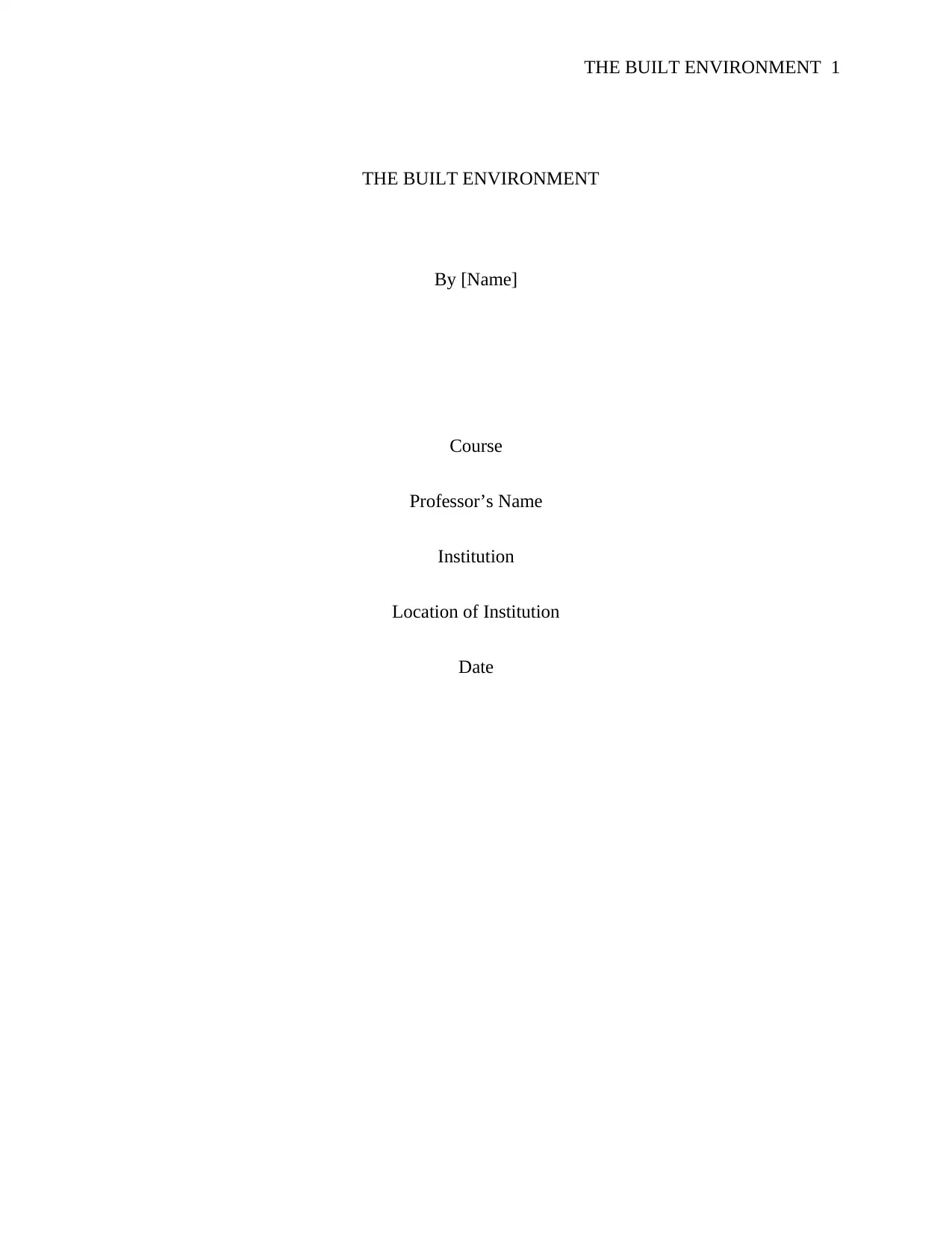
THE BUILT ENVIRONMENT 1
THE BUILT ENVIRONMENT
By [Name]
Course
Professor’s Name
Institution
Location of Institution
Date
THE BUILT ENVIRONMENT
By [Name]
Course
Professor’s Name
Institution
Location of Institution
Date
Paraphrase This Document
Need a fresh take? Get an instant paraphrase of this document with our AI Paraphraser
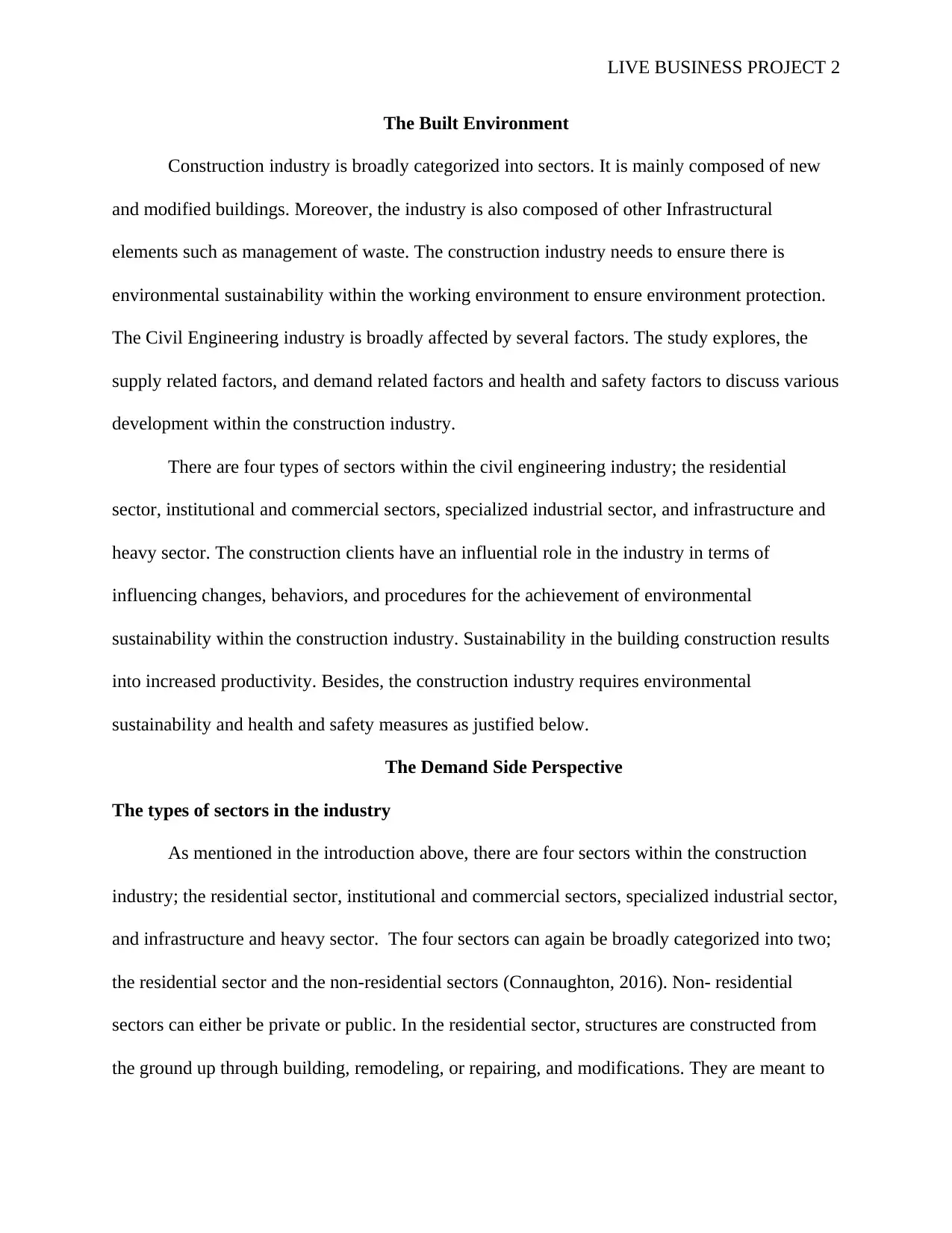
LIVE BUSINESS PROJECT 2
The Built Environment
Construction industry is broadly categorized into sectors. It is mainly composed of new
and modified buildings. Moreover, the industry is also composed of other Infrastructural
elements such as management of waste. The construction industry needs to ensure there is
environmental sustainability within the working environment to ensure environment protection.
The Civil Engineering industry is broadly affected by several factors. The study explores, the
supply related factors, and demand related factors and health and safety factors to discuss various
development within the construction industry.
There are four types of sectors within the civil engineering industry; the residential
sector, institutional and commercial sectors, specialized industrial sector, and infrastructure and
heavy sector. The construction clients have an influential role in the industry in terms of
influencing changes, behaviors, and procedures for the achievement of environmental
sustainability within the construction industry. Sustainability in the building construction results
into increased productivity. Besides, the construction industry requires environmental
sustainability and health and safety measures as justified below.
The Demand Side Perspective
The types of sectors in the industry
As mentioned in the introduction above, there are four sectors within the construction
industry; the residential sector, institutional and commercial sectors, specialized industrial sector,
and infrastructure and heavy sector. The four sectors can again be broadly categorized into two;
the residential sector and the non-residential sectors (Connaughton, 2016). Non- residential
sectors can either be private or public. In the residential sector, structures are constructed from
the ground up through building, remodeling, or repairing, and modifications. They are meant to
The Built Environment
Construction industry is broadly categorized into sectors. It is mainly composed of new
and modified buildings. Moreover, the industry is also composed of other Infrastructural
elements such as management of waste. The construction industry needs to ensure there is
environmental sustainability within the working environment to ensure environment protection.
The Civil Engineering industry is broadly affected by several factors. The study explores, the
supply related factors, and demand related factors and health and safety factors to discuss various
development within the construction industry.
There are four types of sectors within the civil engineering industry; the residential
sector, institutional and commercial sectors, specialized industrial sector, and infrastructure and
heavy sector. The construction clients have an influential role in the industry in terms of
influencing changes, behaviors, and procedures for the achievement of environmental
sustainability within the construction industry. Sustainability in the building construction results
into increased productivity. Besides, the construction industry requires environmental
sustainability and health and safety measures as justified below.
The Demand Side Perspective
The types of sectors in the industry
As mentioned in the introduction above, there are four sectors within the construction
industry; the residential sector, institutional and commercial sectors, specialized industrial sector,
and infrastructure and heavy sector. The four sectors can again be broadly categorized into two;
the residential sector and the non-residential sectors (Connaughton, 2016). Non- residential
sectors can either be private or public. In the residential sector, structures are constructed from
the ground up through building, remodeling, or repairing, and modifications. They are meant to
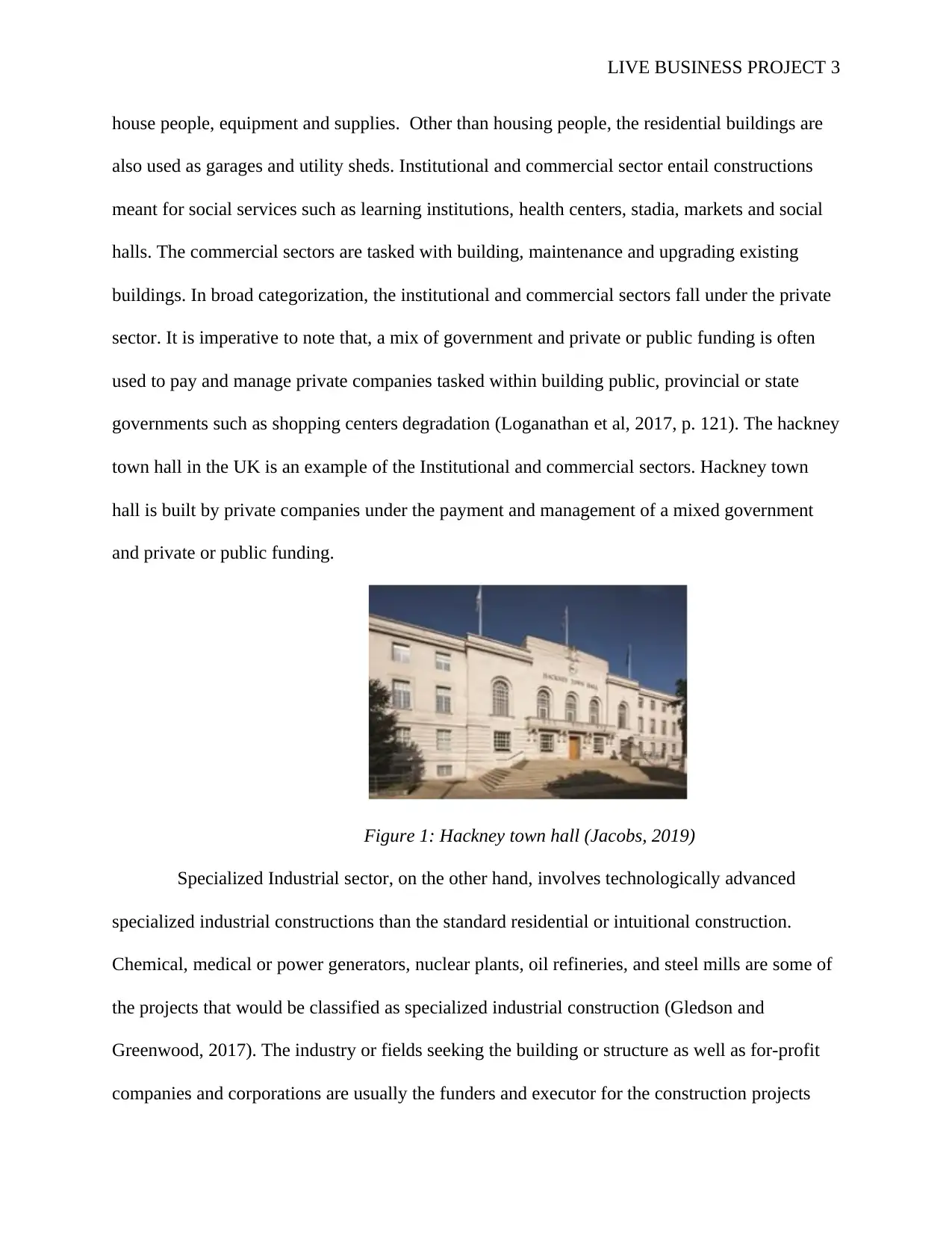
LIVE BUSINESS PROJECT 3
house people, equipment and supplies. Other than housing people, the residential buildings are
also used as garages and utility sheds. Institutional and commercial sector entail constructions
meant for social services such as learning institutions, health centers, stadia, markets and social
halls. The commercial sectors are tasked with building, maintenance and upgrading existing
buildings. In broad categorization, the institutional and commercial sectors fall under the private
sector. It is imperative to note that, a mix of government and private or public funding is often
used to pay and manage private companies tasked within building public, provincial or state
governments such as shopping centers degradation (Loganathan et al, 2017, p. 121). The hackney
town hall in the UK is an example of the Institutional and commercial sectors. Hackney town
hall is built by private companies under the payment and management of a mixed government
and private or public funding.
Figure 1: Hackney town hall (Jacobs, 2019)
Specialized Industrial sector, on the other hand, involves technologically advanced
specialized industrial constructions than the standard residential or intuitional construction.
Chemical, medical or power generators, nuclear plants, oil refineries, and steel mills are some of
the projects that would be classified as specialized industrial construction (Gledson and
Greenwood, 2017). The industry or fields seeking the building or structure as well as for-profit
companies and corporations are usually the funders and executor for the construction projects
house people, equipment and supplies. Other than housing people, the residential buildings are
also used as garages and utility sheds. Institutional and commercial sector entail constructions
meant for social services such as learning institutions, health centers, stadia, markets and social
halls. The commercial sectors are tasked with building, maintenance and upgrading existing
buildings. In broad categorization, the institutional and commercial sectors fall under the private
sector. It is imperative to note that, a mix of government and private or public funding is often
used to pay and manage private companies tasked within building public, provincial or state
governments such as shopping centers degradation (Loganathan et al, 2017, p. 121). The hackney
town hall in the UK is an example of the Institutional and commercial sectors. Hackney town
hall is built by private companies under the payment and management of a mixed government
and private or public funding.
Figure 1: Hackney town hall (Jacobs, 2019)
Specialized Industrial sector, on the other hand, involves technologically advanced
specialized industrial constructions than the standard residential or intuitional construction.
Chemical, medical or power generators, nuclear plants, oil refineries, and steel mills are some of
the projects that would be classified as specialized industrial construction (Gledson and
Greenwood, 2017). The industry or fields seeking the building or structure as well as for-profit
companies and corporations are usually the funders and executor for the construction projects
⊘ This is a preview!⊘
Do you want full access?
Subscribe today to unlock all pages.

Trusted by 1+ million students worldwide
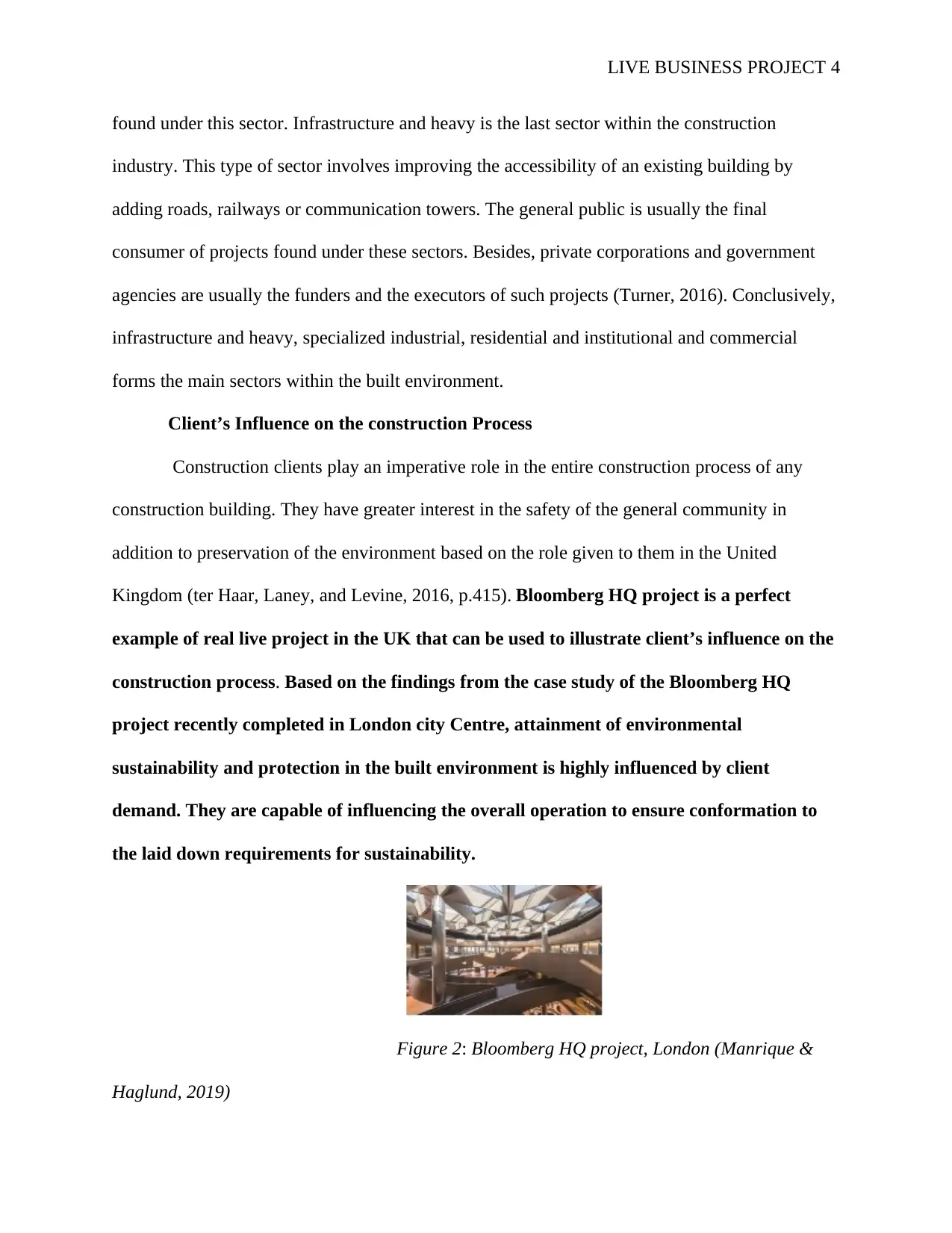
LIVE BUSINESS PROJECT 4
found under this sector. Infrastructure and heavy is the last sector within the construction
industry. This type of sector involves improving the accessibility of an existing building by
adding roads, railways or communication towers. The general public is usually the final
consumer of projects found under these sectors. Besides, private corporations and government
agencies are usually the funders and the executors of such projects (Turner, 2016). Conclusively,
infrastructure and heavy, specialized industrial, residential and institutional and commercial
forms the main sectors within the built environment.
Client’s Influence on the construction Process
Construction clients play an imperative role in the entire construction process of any
construction building. They have greater interest in the safety of the general community in
addition to preservation of the environment based on the role given to them in the United
Kingdom (ter Haar, Laney, and Levine, 2016, p.415). Bloomberg HQ project is a perfect
example of real live project in the UK that can be used to illustrate client’s influence on the
construction process. Based on the findings from the case study of the Bloomberg HQ
project recently completed in London city Centre, attainment of environmental
sustainability and protection in the built environment is highly influenced by client
demand. They are capable of influencing the overall operation to ensure conformation to
the laid down requirements for sustainability.
Figure 2: Bloomberg HQ project, London (Manrique &
Haglund, 2019)
found under this sector. Infrastructure and heavy is the last sector within the construction
industry. This type of sector involves improving the accessibility of an existing building by
adding roads, railways or communication towers. The general public is usually the final
consumer of projects found under these sectors. Besides, private corporations and government
agencies are usually the funders and the executors of such projects (Turner, 2016). Conclusively,
infrastructure and heavy, specialized industrial, residential and institutional and commercial
forms the main sectors within the built environment.
Client’s Influence on the construction Process
Construction clients play an imperative role in the entire construction process of any
construction building. They have greater interest in the safety of the general community in
addition to preservation of the environment based on the role given to them in the United
Kingdom (ter Haar, Laney, and Levine, 2016, p.415). Bloomberg HQ project is a perfect
example of real live project in the UK that can be used to illustrate client’s influence on the
construction process. Based on the findings from the case study of the Bloomberg HQ
project recently completed in London city Centre, attainment of environmental
sustainability and protection in the built environment is highly influenced by client
demand. They are capable of influencing the overall operation to ensure conformation to
the laid down requirements for sustainability.
Figure 2: Bloomberg HQ project, London (Manrique &
Haglund, 2019)
Paraphrase This Document
Need a fresh take? Get an instant paraphrase of this document with our AI Paraphraser
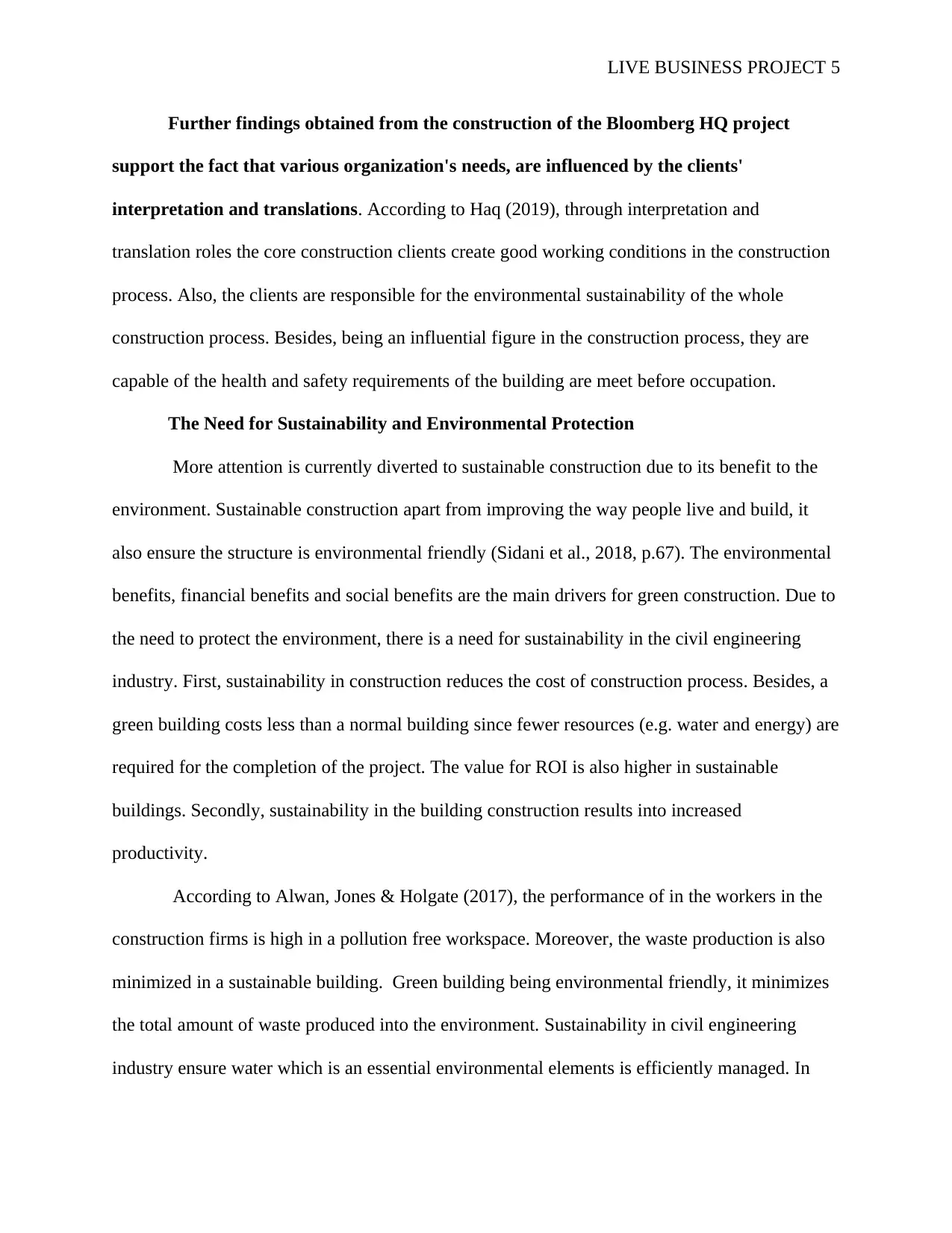
LIVE BUSINESS PROJECT 5
Further findings obtained from the construction of the Bloomberg HQ project
support the fact that various organization's needs, are influenced by the clients'
interpretation and translations. According to Haq (2019), through interpretation and
translation roles the core construction clients create good working conditions in the construction
process. Also, the clients are responsible for the environmental sustainability of the whole
construction process. Besides, being an influential figure in the construction process, they are
capable of the health and safety requirements of the building are meet before occupation.
The Need for Sustainability and Environmental Protection
More attention is currently diverted to sustainable construction due to its benefit to the
environment. Sustainable construction apart from improving the way people live and build, it
also ensure the structure is environmental friendly (Sidani et al., 2018, p.67). The environmental
benefits, financial benefits and social benefits are the main drivers for green construction. Due to
the need to protect the environment, there is a need for sustainability in the civil engineering
industry. First, sustainability in construction reduces the cost of construction process. Besides, a
green building costs less than a normal building since fewer resources (e.g. water and energy) are
required for the completion of the project. The value for ROI is also higher in sustainable
buildings. Secondly, sustainability in the building construction results into increased
productivity.
According to Alwan, Jones & Holgate (2017), the performance of in the workers in the
construction firms is high in a pollution free workspace. Moreover, the waste production is also
minimized in a sustainable building. Green building being environmental friendly, it minimizes
the total amount of waste produced into the environment. Sustainability in civil engineering
industry ensure water which is an essential environmental elements is efficiently managed. In
Further findings obtained from the construction of the Bloomberg HQ project
support the fact that various organization's needs, are influenced by the clients'
interpretation and translations. According to Haq (2019), through interpretation and
translation roles the core construction clients create good working conditions in the construction
process. Also, the clients are responsible for the environmental sustainability of the whole
construction process. Besides, being an influential figure in the construction process, they are
capable of the health and safety requirements of the building are meet before occupation.
The Need for Sustainability and Environmental Protection
More attention is currently diverted to sustainable construction due to its benefit to the
environment. Sustainable construction apart from improving the way people live and build, it
also ensure the structure is environmental friendly (Sidani et al., 2018, p.67). The environmental
benefits, financial benefits and social benefits are the main drivers for green construction. Due to
the need to protect the environment, there is a need for sustainability in the civil engineering
industry. First, sustainability in construction reduces the cost of construction process. Besides, a
green building costs less than a normal building since fewer resources (e.g. water and energy) are
required for the completion of the project. The value for ROI is also higher in sustainable
buildings. Secondly, sustainability in the building construction results into increased
productivity.
According to Alwan, Jones & Holgate (2017), the performance of in the workers in the
construction firms is high in a pollution free workspace. Moreover, the waste production is also
minimized in a sustainable building. Green building being environmental friendly, it minimizes
the total amount of waste produced into the environment. Sustainability in civil engineering
industry ensure water which is an essential environmental elements is efficiently managed. In
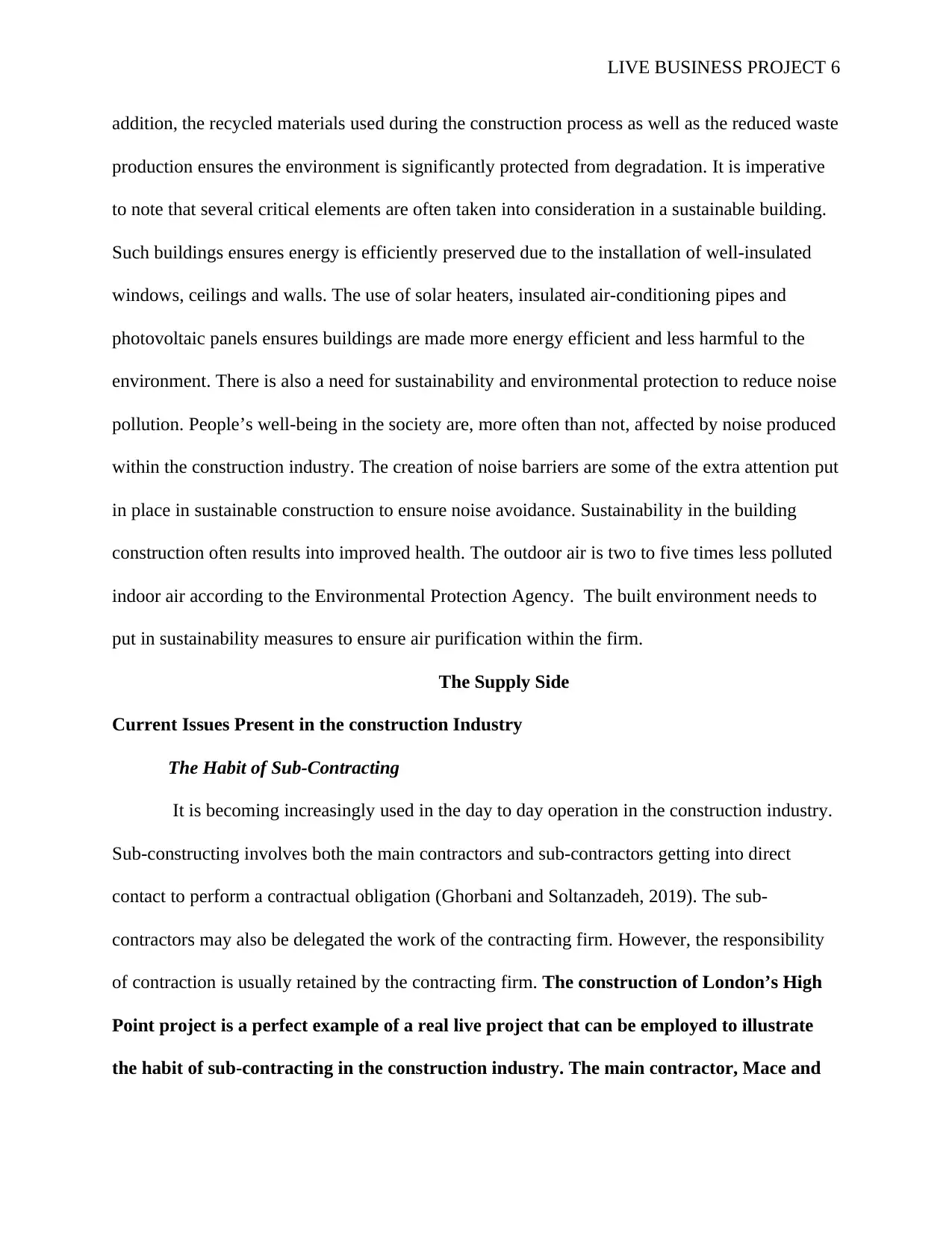
LIVE BUSINESS PROJECT 6
addition, the recycled materials used during the construction process as well as the reduced waste
production ensures the environment is significantly protected from degradation. It is imperative
to note that several critical elements are often taken into consideration in a sustainable building.
Such buildings ensures energy is efficiently preserved due to the installation of well-insulated
windows, ceilings and walls. The use of solar heaters, insulated air-conditioning pipes and
photovoltaic panels ensures buildings are made more energy efficient and less harmful to the
environment. There is also a need for sustainability and environmental protection to reduce noise
pollution. People’s well-being in the society are, more often than not, affected by noise produced
within the construction industry. The creation of noise barriers are some of the extra attention put
in place in sustainable construction to ensure noise avoidance. Sustainability in the building
construction often results into improved health. The outdoor air is two to five times less polluted
indoor air according to the Environmental Protection Agency. The built environment needs to
put in sustainability measures to ensure air purification within the firm.
The Supply Side
Current Issues Present in the construction Industry
The Habit of Sub-Contracting
It is becoming increasingly used in the day to day operation in the construction industry.
Sub-constructing involves both the main contractors and sub-contractors getting into direct
contact to perform a contractual obligation (Ghorbani and Soltanzadeh, 2019). The sub-
contractors may also be delegated the work of the contracting firm. However, the responsibility
of contraction is usually retained by the contracting firm. The construction of London’s High
Point project is a perfect example of a real live project that can be employed to illustrate
the habit of sub-contracting in the construction industry. The main contractor, Mace and
addition, the recycled materials used during the construction process as well as the reduced waste
production ensures the environment is significantly protected from degradation. It is imperative
to note that several critical elements are often taken into consideration in a sustainable building.
Such buildings ensures energy is efficiently preserved due to the installation of well-insulated
windows, ceilings and walls. The use of solar heaters, insulated air-conditioning pipes and
photovoltaic panels ensures buildings are made more energy efficient and less harmful to the
environment. There is also a need for sustainability and environmental protection to reduce noise
pollution. People’s well-being in the society are, more often than not, affected by noise produced
within the construction industry. The creation of noise barriers are some of the extra attention put
in place in sustainable construction to ensure noise avoidance. Sustainability in the building
construction often results into improved health. The outdoor air is two to five times less polluted
indoor air according to the Environmental Protection Agency. The built environment needs to
put in sustainability measures to ensure air purification within the firm.
The Supply Side
Current Issues Present in the construction Industry
The Habit of Sub-Contracting
It is becoming increasingly used in the day to day operation in the construction industry.
Sub-constructing involves both the main contractors and sub-contractors getting into direct
contact to perform a contractual obligation (Ghorbani and Soltanzadeh, 2019). The sub-
contractors may also be delegated the work of the contracting firm. However, the responsibility
of contraction is usually retained by the contracting firm. The construction of London’s High
Point project is a perfect example of a real live project that can be employed to illustrate
the habit of sub-contracting in the construction industry. The main contractor, Mace and
⊘ This is a preview!⊘
Do you want full access?
Subscribe today to unlock all pages.

Trusted by 1+ million students worldwide
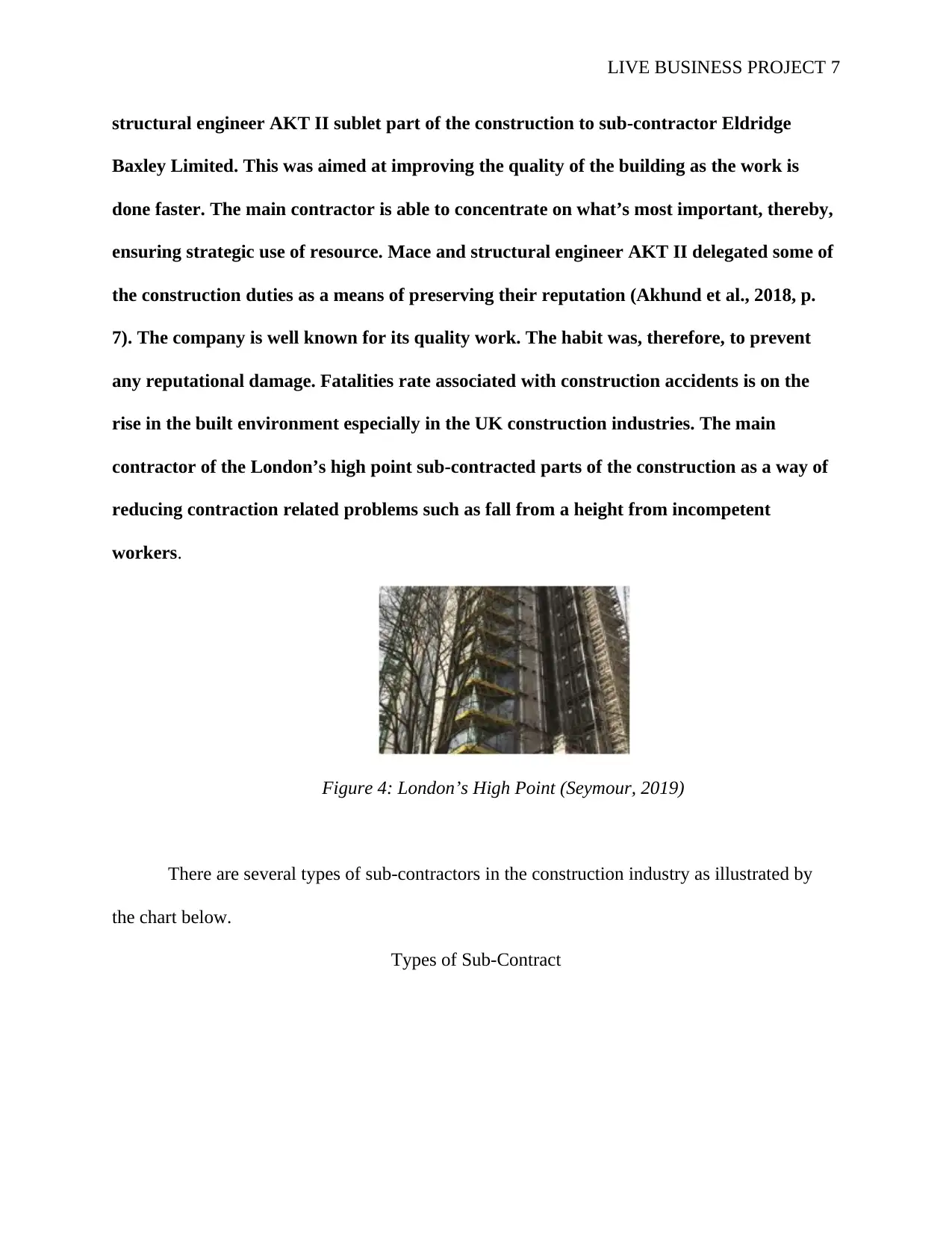
LIVE BUSINESS PROJECT 7
structural engineer AKT II sublet part of the construction to sub-contractor Eldridge
Baxley Limited. This was aimed at improving the quality of the building as the work is
done faster. The main contractor is able to concentrate on what’s most important, thereby,
ensuring strategic use of resource. Mace and structural engineer AKT II delegated some of
the construction duties as a means of preserving their reputation (Akhund et al., 2018, p.
7). The company is well known for its quality work. The habit was, therefore, to prevent
any reputational damage. Fatalities rate associated with construction accidents is on the
rise in the built environment especially in the UK construction industries. The main
contractor of the London’s high point sub-contracted parts of the construction as a way of
reducing contraction related problems such as fall from a height from incompetent
workers.
Figure 4: London’s High Point (Seymour, 2019)
There are several types of sub-contractors in the construction industry as illustrated by
the chart below.
Types of Sub-Contract
structural engineer AKT II sublet part of the construction to sub-contractor Eldridge
Baxley Limited. This was aimed at improving the quality of the building as the work is
done faster. The main contractor is able to concentrate on what’s most important, thereby,
ensuring strategic use of resource. Mace and structural engineer AKT II delegated some of
the construction duties as a means of preserving their reputation (Akhund et al., 2018, p.
7). The company is well known for its quality work. The habit was, therefore, to prevent
any reputational damage. Fatalities rate associated with construction accidents is on the
rise in the built environment especially in the UK construction industries. The main
contractor of the London’s high point sub-contracted parts of the construction as a way of
reducing contraction related problems such as fall from a height from incompetent
workers.
Figure 4: London’s High Point (Seymour, 2019)
There are several types of sub-contractors in the construction industry as illustrated by
the chart below.
Types of Sub-Contract
Paraphrase This Document
Need a fresh take? Get an instant paraphrase of this document with our AI Paraphraser
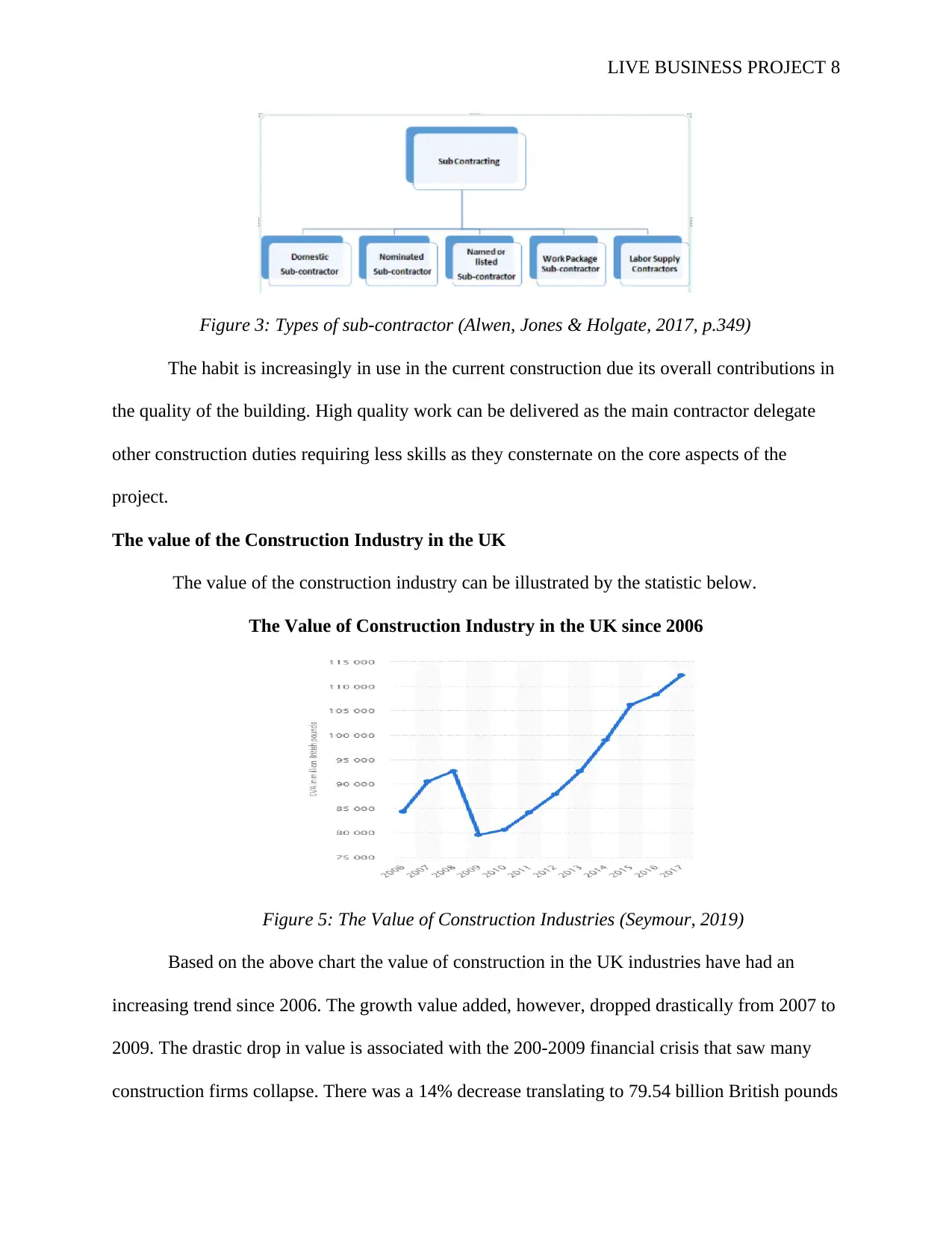
LIVE BUSINESS PROJECT 8
Figure 3: Types of sub-contractor (Alwen, Jones & Holgate, 2017, p.349)
The habit is increasingly in use in the current construction due its overall contributions in
the quality of the building. High quality work can be delivered as the main contractor delegate
other construction duties requiring less skills as they consternate on the core aspects of the
project.
The value of the Construction Industry in the UK
The value of the construction industry can be illustrated by the statistic below.
The Value of Construction Industry in the UK since 2006
Figure 5: The Value of Construction Industries (Seymour, 2019)
Based on the above chart the value of construction in the UK industries have had an
increasing trend since 2006. The growth value added, however, dropped drastically from 2007 to
2009. The drastic drop in value is associated with the 200-2009 financial crisis that saw many
construction firms collapse. There was a 14% decrease translating to 79.54 billion British pounds
Figure 3: Types of sub-contractor (Alwen, Jones & Holgate, 2017, p.349)
The habit is increasingly in use in the current construction due its overall contributions in
the quality of the building. High quality work can be delivered as the main contractor delegate
other construction duties requiring less skills as they consternate on the core aspects of the
project.
The value of the Construction Industry in the UK
The value of the construction industry can be illustrated by the statistic below.
The Value of Construction Industry in the UK since 2006
Figure 5: The Value of Construction Industries (Seymour, 2019)
Based on the above chart the value of construction in the UK industries have had an
increasing trend since 2006. The growth value added, however, dropped drastically from 2007 to
2009. The drastic drop in value is associated with the 200-2009 financial crisis that saw many
construction firms collapse. There was a 14% decrease translating to 79.54 billion British pounds
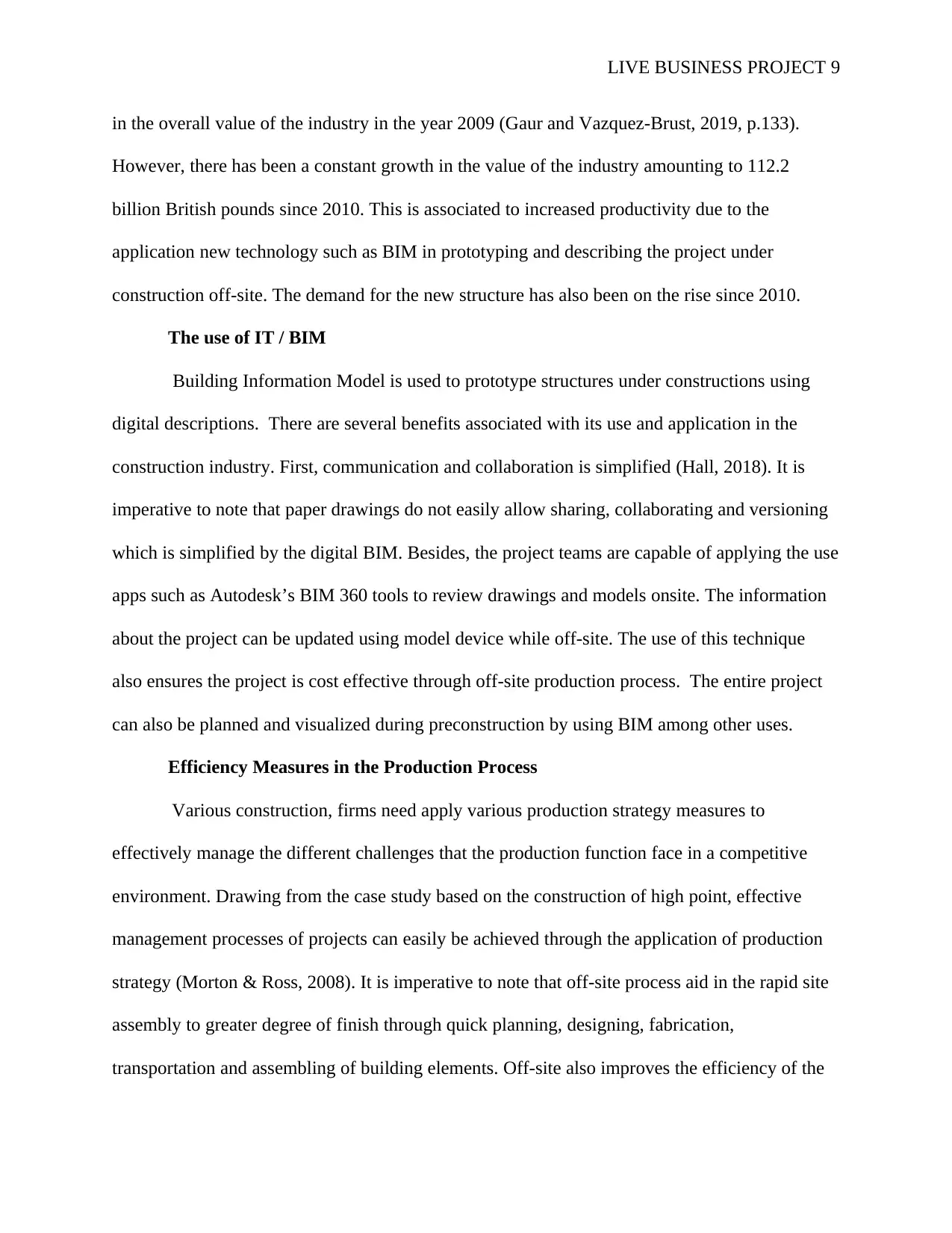
LIVE BUSINESS PROJECT 9
in the overall value of the industry in the year 2009 (Gaur and Vazquez-Brust, 2019, p.133).
However, there has been a constant growth in the value of the industry amounting to 112.2
billion British pounds since 2010. This is associated to increased productivity due to the
application new technology such as BIM in prototyping and describing the project under
construction off-site. The demand for the new structure has also been on the rise since 2010.
The use of IT / BIM
Building Information Model is used to prototype structures under constructions using
digital descriptions. There are several benefits associated with its use and application in the
construction industry. First, communication and collaboration is simplified (Hall, 2018). It is
imperative to note that paper drawings do not easily allow sharing, collaborating and versioning
which is simplified by the digital BIM. Besides, the project teams are capable of applying the use
apps such as Autodesk’s BIM 360 tools to review drawings and models onsite. The information
about the project can be updated using model device while off-site. The use of this technique
also ensures the project is cost effective through off-site production process. The entire project
can also be planned and visualized during preconstruction by using BIM among other uses.
Efficiency Measures in the Production Process
Various construction, firms need apply various production strategy measures to
effectively manage the different challenges that the production function face in a competitive
environment. Drawing from the case study based on the construction of high point, effective
management processes of projects can easily be achieved through the application of production
strategy (Morton & Ross, 2008). It is imperative to note that off-site process aid in the rapid site
assembly to greater degree of finish through quick planning, designing, fabrication,
transportation and assembling of building elements. Off-site also improves the efficiency of the
in the overall value of the industry in the year 2009 (Gaur and Vazquez-Brust, 2019, p.133).
However, there has been a constant growth in the value of the industry amounting to 112.2
billion British pounds since 2010. This is associated to increased productivity due to the
application new technology such as BIM in prototyping and describing the project under
construction off-site. The demand for the new structure has also been on the rise since 2010.
The use of IT / BIM
Building Information Model is used to prototype structures under constructions using
digital descriptions. There are several benefits associated with its use and application in the
construction industry. First, communication and collaboration is simplified (Hall, 2018). It is
imperative to note that paper drawings do not easily allow sharing, collaborating and versioning
which is simplified by the digital BIM. Besides, the project teams are capable of applying the use
apps such as Autodesk’s BIM 360 tools to review drawings and models onsite. The information
about the project can be updated using model device while off-site. The use of this technique
also ensures the project is cost effective through off-site production process. The entire project
can also be planned and visualized during preconstruction by using BIM among other uses.
Efficiency Measures in the Production Process
Various construction, firms need apply various production strategy measures to
effectively manage the different challenges that the production function face in a competitive
environment. Drawing from the case study based on the construction of high point, effective
management processes of projects can easily be achieved through the application of production
strategy (Morton & Ross, 2008). It is imperative to note that off-site process aid in the rapid site
assembly to greater degree of finish through quick planning, designing, fabrication,
transportation and assembling of building elements. Off-site also improves the efficiency of the
⊘ This is a preview!⊘
Do you want full access?
Subscribe today to unlock all pages.

Trusted by 1+ million students worldwide
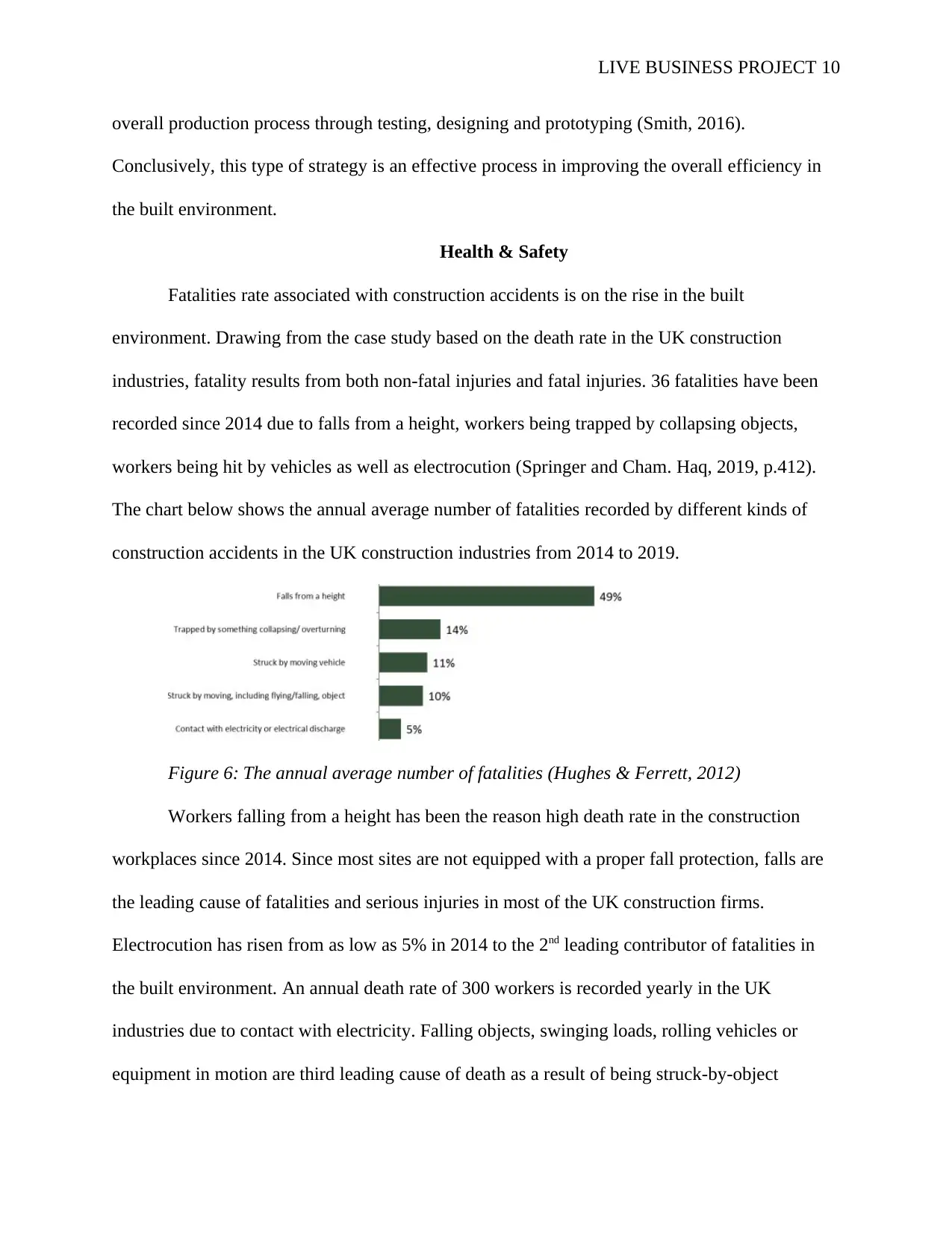
LIVE BUSINESS PROJECT 10
overall production process through testing, designing and prototyping (Smith, 2016).
Conclusively, this type of strategy is an effective process in improving the overall efficiency in
the built environment.
Health & Safety
Fatalities rate associated with construction accidents is on the rise in the built
environment. Drawing from the case study based on the death rate in the UK construction
industries, fatality results from both non-fatal injuries and fatal injuries. 36 fatalities have been
recorded since 2014 due to falls from a height, workers being trapped by collapsing objects,
workers being hit by vehicles as well as electrocution (Springer and Cham. Haq, 2019, p.412).
The chart below shows the annual average number of fatalities recorded by different kinds of
construction accidents in the UK construction industries from 2014 to 2019.
Figure 6: The annual average number of fatalities (Hughes & Ferrett, 2012)
Workers falling from a height has been the reason high death rate in the construction
workplaces since 2014. Since most sites are not equipped with a proper fall protection, falls are
the leading cause of fatalities and serious injuries in most of the UK construction firms.
Electrocution has risen from as low as 5% in 2014 to the 2nd leading contributor of fatalities in
the built environment. An annual death rate of 300 workers is recorded yearly in the UK
industries due to contact with electricity. Falling objects, swinging loads, rolling vehicles or
equipment in motion are third leading cause of death as a result of being struck-by-object
overall production process through testing, designing and prototyping (Smith, 2016).
Conclusively, this type of strategy is an effective process in improving the overall efficiency in
the built environment.
Health & Safety
Fatalities rate associated with construction accidents is on the rise in the built
environment. Drawing from the case study based on the death rate in the UK construction
industries, fatality results from both non-fatal injuries and fatal injuries. 36 fatalities have been
recorded since 2014 due to falls from a height, workers being trapped by collapsing objects,
workers being hit by vehicles as well as electrocution (Springer and Cham. Haq, 2019, p.412).
The chart below shows the annual average number of fatalities recorded by different kinds of
construction accidents in the UK construction industries from 2014 to 2019.
Figure 6: The annual average number of fatalities (Hughes & Ferrett, 2012)
Workers falling from a height has been the reason high death rate in the construction
workplaces since 2014. Since most sites are not equipped with a proper fall protection, falls are
the leading cause of fatalities and serious injuries in most of the UK construction firms.
Electrocution has risen from as low as 5% in 2014 to the 2nd leading contributor of fatalities in
the built environment. An annual death rate of 300 workers is recorded yearly in the UK
industries due to contact with electricity. Falling objects, swinging loads, rolling vehicles or
equipment in motion are third leading cause of death as a result of being struck-by-object
Paraphrase This Document
Need a fresh take? Get an instant paraphrase of this document with our AI Paraphraser
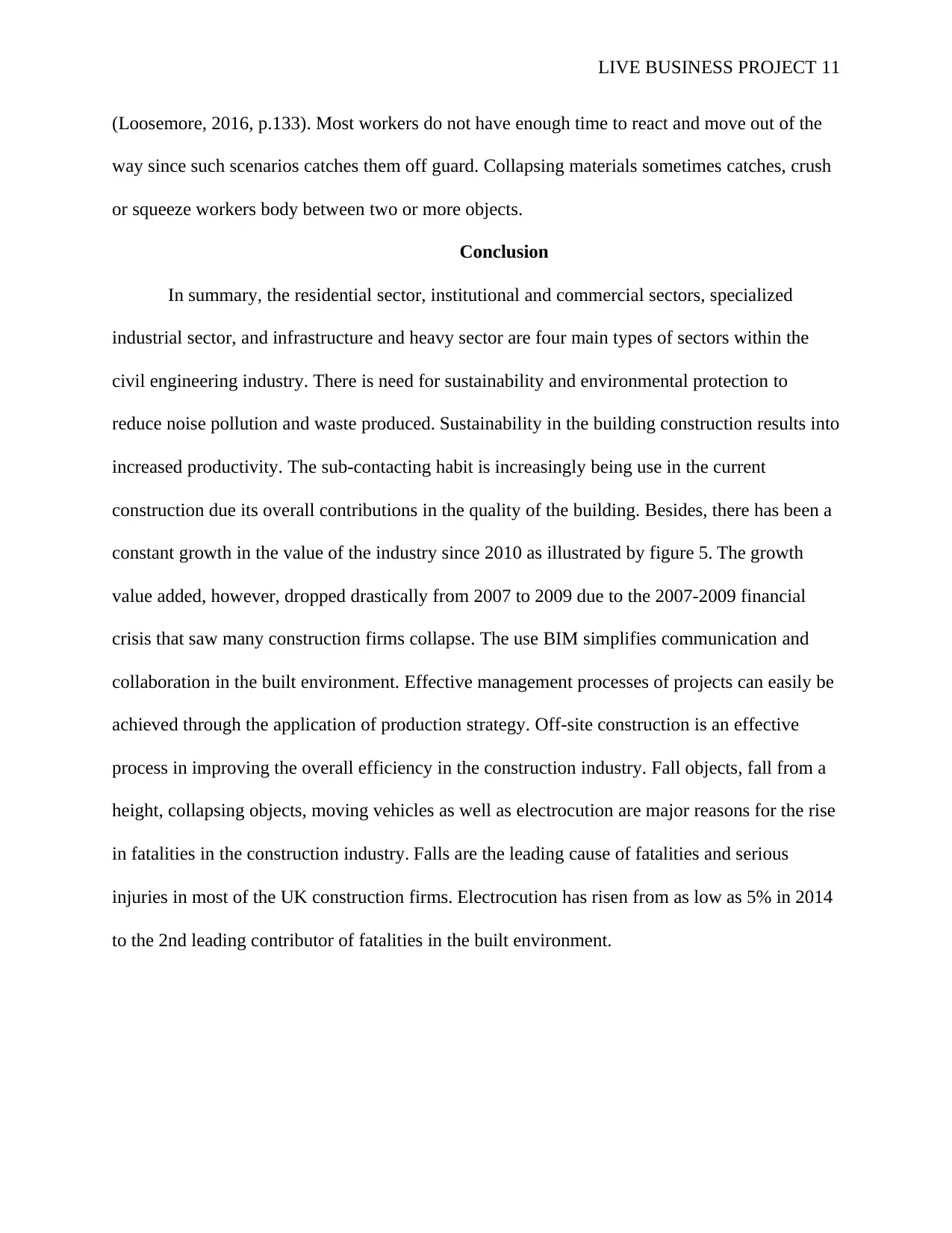
LIVE BUSINESS PROJECT 11
(Loosemore, 2016, p.133). Most workers do not have enough time to react and move out of the
way since such scenarios catches them off guard. Collapsing materials sometimes catches, crush
or squeeze workers body between two or more objects.
Conclusion
In summary, the residential sector, institutional and commercial sectors, specialized
industrial sector, and infrastructure and heavy sector are four main types of sectors within the
civil engineering industry. There is need for sustainability and environmental protection to
reduce noise pollution and waste produced. Sustainability in the building construction results into
increased productivity. The sub-contacting habit is increasingly being use in the current
construction due its overall contributions in the quality of the building. Besides, there has been a
constant growth in the value of the industry since 2010 as illustrated by figure 5. The growth
value added, however, dropped drastically from 2007 to 2009 due to the 2007-2009 financial
crisis that saw many construction firms collapse. The use BIM simplifies communication and
collaboration in the built environment. Effective management processes of projects can easily be
achieved through the application of production strategy. Off-site construction is an effective
process in improving the overall efficiency in the construction industry. Fall objects, fall from a
height, collapsing objects, moving vehicles as well as electrocution are major reasons for the rise
in fatalities in the construction industry. Falls are the leading cause of fatalities and serious
injuries in most of the UK construction firms. Electrocution has risen from as low as 5% in 2014
to the 2nd leading contributor of fatalities in the built environment.
(Loosemore, 2016, p.133). Most workers do not have enough time to react and move out of the
way since such scenarios catches them off guard. Collapsing materials sometimes catches, crush
or squeeze workers body between two or more objects.
Conclusion
In summary, the residential sector, institutional and commercial sectors, specialized
industrial sector, and infrastructure and heavy sector are four main types of sectors within the
civil engineering industry. There is need for sustainability and environmental protection to
reduce noise pollution and waste produced. Sustainability in the building construction results into
increased productivity. The sub-contacting habit is increasingly being use in the current
construction due its overall contributions in the quality of the building. Besides, there has been a
constant growth in the value of the industry since 2010 as illustrated by figure 5. The growth
value added, however, dropped drastically from 2007 to 2009 due to the 2007-2009 financial
crisis that saw many construction firms collapse. The use BIM simplifies communication and
collaboration in the built environment. Effective management processes of projects can easily be
achieved through the application of production strategy. Off-site construction is an effective
process in improving the overall efficiency in the construction industry. Fall objects, fall from a
height, collapsing objects, moving vehicles as well as electrocution are major reasons for the rise
in fatalities in the construction industry. Falls are the leading cause of fatalities and serious
injuries in most of the UK construction firms. Electrocution has risen from as low as 5% in 2014
to the 2nd leading contributor of fatalities in the built environment.
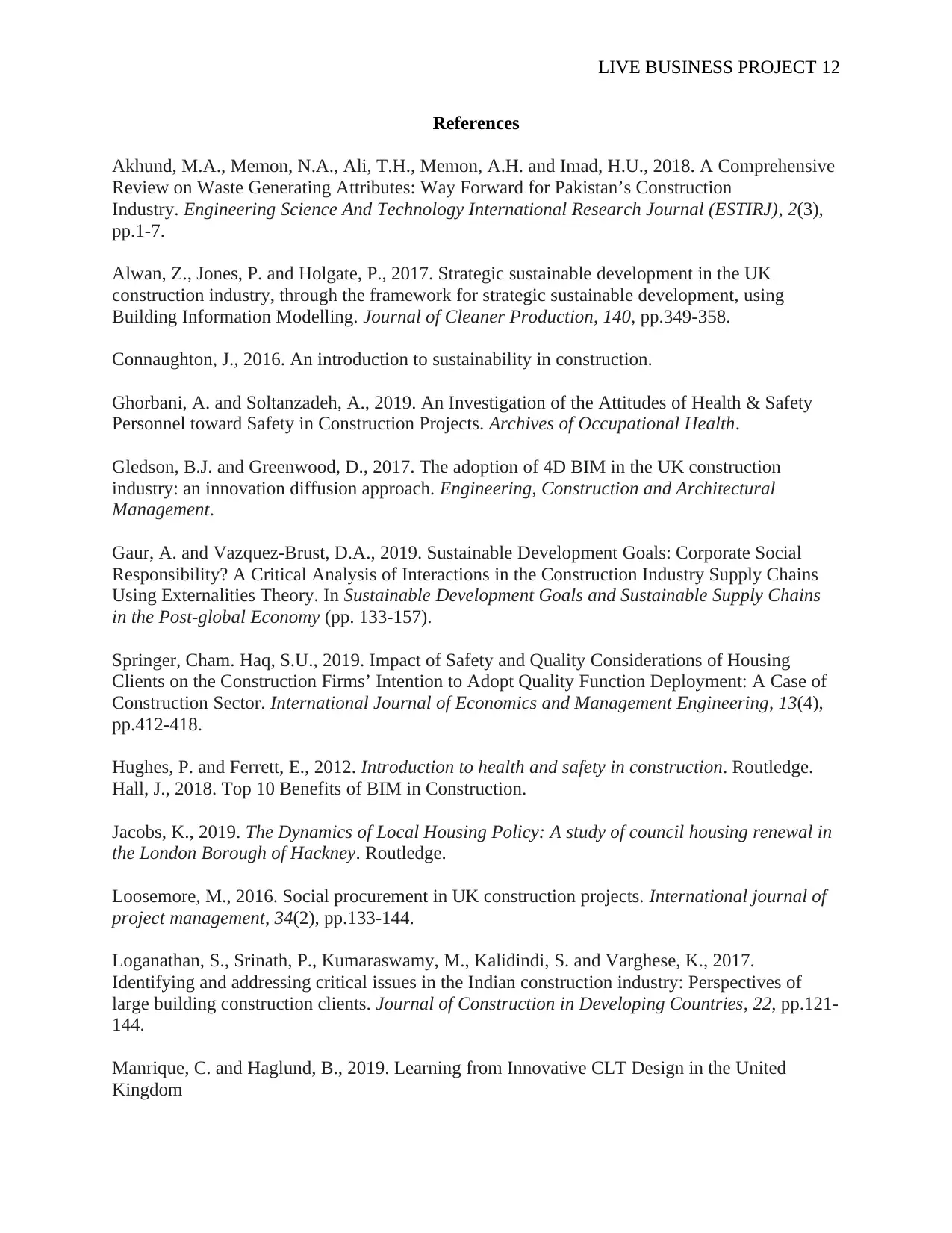
LIVE BUSINESS PROJECT 12
References
Akhund, M.A., Memon, N.A., Ali, T.H., Memon, A.H. and Imad, H.U., 2018. A Comprehensive
Review on Waste Generating Attributes: Way Forward for Pakistan’s Construction
Industry. Engineering Science And Technology International Research Journal (ESTIRJ), 2(3),
pp.1-7.
Alwan, Z., Jones, P. and Holgate, P., 2017. Strategic sustainable development in the UK
construction industry, through the framework for strategic sustainable development, using
Building Information Modelling. Journal of Cleaner Production, 140, pp.349-358.
Connaughton, J., 2016. An introduction to sustainability in construction.
Ghorbani, A. and Soltanzadeh, A., 2019. An Investigation of the Attitudes of Health & Safety
Personnel toward Safety in Construction Projects. Archives of Occupational Health.
Gledson, B.J. and Greenwood, D., 2017. The adoption of 4D BIM in the UK construction
industry: an innovation diffusion approach. Engineering, Construction and Architectural
Management.
Gaur, A. and Vazquez-Brust, D.A., 2019. Sustainable Development Goals: Corporate Social
Responsibility? A Critical Analysis of Interactions in the Construction Industry Supply Chains
Using Externalities Theory. In Sustainable Development Goals and Sustainable Supply Chains
in the Post-global Economy (pp. 133-157).
Springer, Cham. Haq, S.U., 2019. Impact of Safety and Quality Considerations of Housing
Clients on the Construction Firms’ Intention to Adopt Quality Function Deployment: A Case of
Construction Sector. International Journal of Economics and Management Engineering, 13(4),
pp.412-418.
Hughes, P. and Ferrett, E., 2012. Introduction to health and safety in construction. Routledge.
Hall, J., 2018. Top 10 Benefits of BIM in Construction.
Jacobs, K., 2019. The Dynamics of Local Housing Policy: A study of council housing renewal in
the London Borough of Hackney. Routledge.
Loosemore, M., 2016. Social procurement in UK construction projects. International journal of
project management, 34(2), pp.133-144.
Loganathan, S., Srinath, P., Kumaraswamy, M., Kalidindi, S. and Varghese, K., 2017.
Identifying and addressing critical issues in the Indian construction industry: Perspectives of
large building construction clients. Journal of Construction in Developing Countries, 22, pp.121-
144.
Manrique, C. and Haglund, B., 2019. Learning from Innovative CLT Design in the United
Kingdom
References
Akhund, M.A., Memon, N.A., Ali, T.H., Memon, A.H. and Imad, H.U., 2018. A Comprehensive
Review on Waste Generating Attributes: Way Forward for Pakistan’s Construction
Industry. Engineering Science And Technology International Research Journal (ESTIRJ), 2(3),
pp.1-7.
Alwan, Z., Jones, P. and Holgate, P., 2017. Strategic sustainable development in the UK
construction industry, through the framework for strategic sustainable development, using
Building Information Modelling. Journal of Cleaner Production, 140, pp.349-358.
Connaughton, J., 2016. An introduction to sustainability in construction.
Ghorbani, A. and Soltanzadeh, A., 2019. An Investigation of the Attitudes of Health & Safety
Personnel toward Safety in Construction Projects. Archives of Occupational Health.
Gledson, B.J. and Greenwood, D., 2017. The adoption of 4D BIM in the UK construction
industry: an innovation diffusion approach. Engineering, Construction and Architectural
Management.
Gaur, A. and Vazquez-Brust, D.A., 2019. Sustainable Development Goals: Corporate Social
Responsibility? A Critical Analysis of Interactions in the Construction Industry Supply Chains
Using Externalities Theory. In Sustainable Development Goals and Sustainable Supply Chains
in the Post-global Economy (pp. 133-157).
Springer, Cham. Haq, S.U., 2019. Impact of Safety and Quality Considerations of Housing
Clients on the Construction Firms’ Intention to Adopt Quality Function Deployment: A Case of
Construction Sector. International Journal of Economics and Management Engineering, 13(4),
pp.412-418.
Hughes, P. and Ferrett, E., 2012. Introduction to health and safety in construction. Routledge.
Hall, J., 2018. Top 10 Benefits of BIM in Construction.
Jacobs, K., 2019. The Dynamics of Local Housing Policy: A study of council housing renewal in
the London Borough of Hackney. Routledge.
Loosemore, M., 2016. Social procurement in UK construction projects. International journal of
project management, 34(2), pp.133-144.
Loganathan, S., Srinath, P., Kumaraswamy, M., Kalidindi, S. and Varghese, K., 2017.
Identifying and addressing critical issues in the Indian construction industry: Perspectives of
large building construction clients. Journal of Construction in Developing Countries, 22, pp.121-
144.
Manrique, C. and Haglund, B., 2019. Learning from Innovative CLT Design in the United
Kingdom
⊘ This is a preview!⊘
Do you want full access?
Subscribe today to unlock all pages.

Trusted by 1+ million students worldwide
1 out of 13
Related Documents
Your All-in-One AI-Powered Toolkit for Academic Success.
+13062052269
info@desklib.com
Available 24*7 on WhatsApp / Email
![[object Object]](/_next/static/media/star-bottom.7253800d.svg)
Unlock your academic potential
Copyright © 2020–2025 A2Z Services. All Rights Reserved. Developed and managed by ZUCOL.


